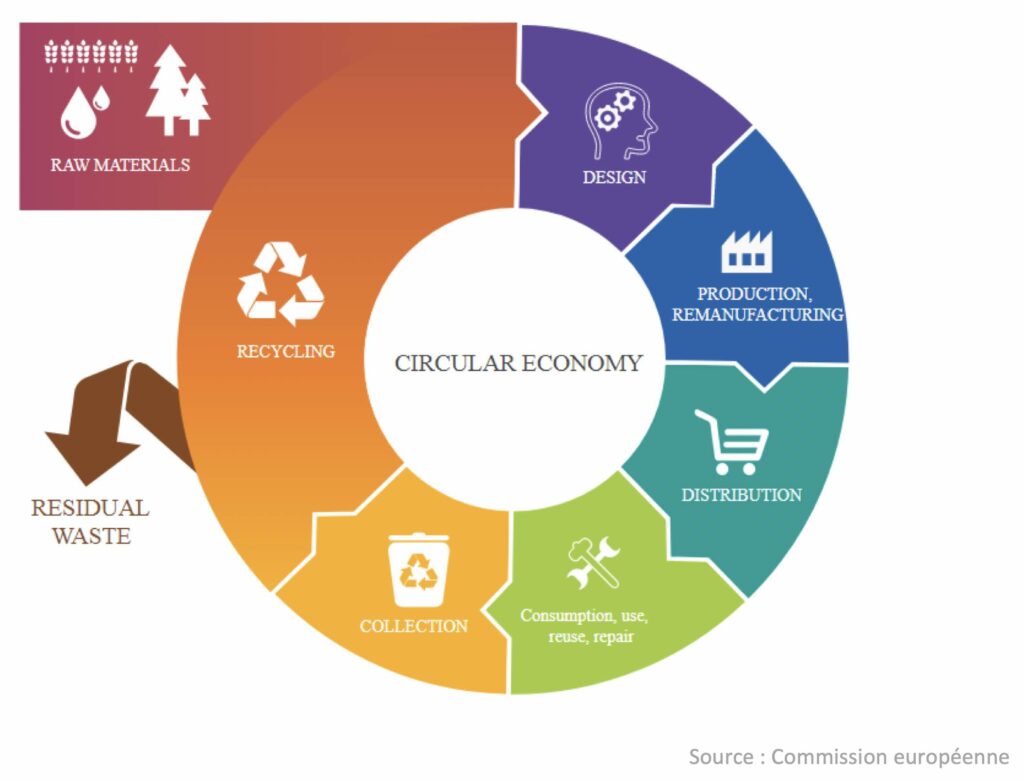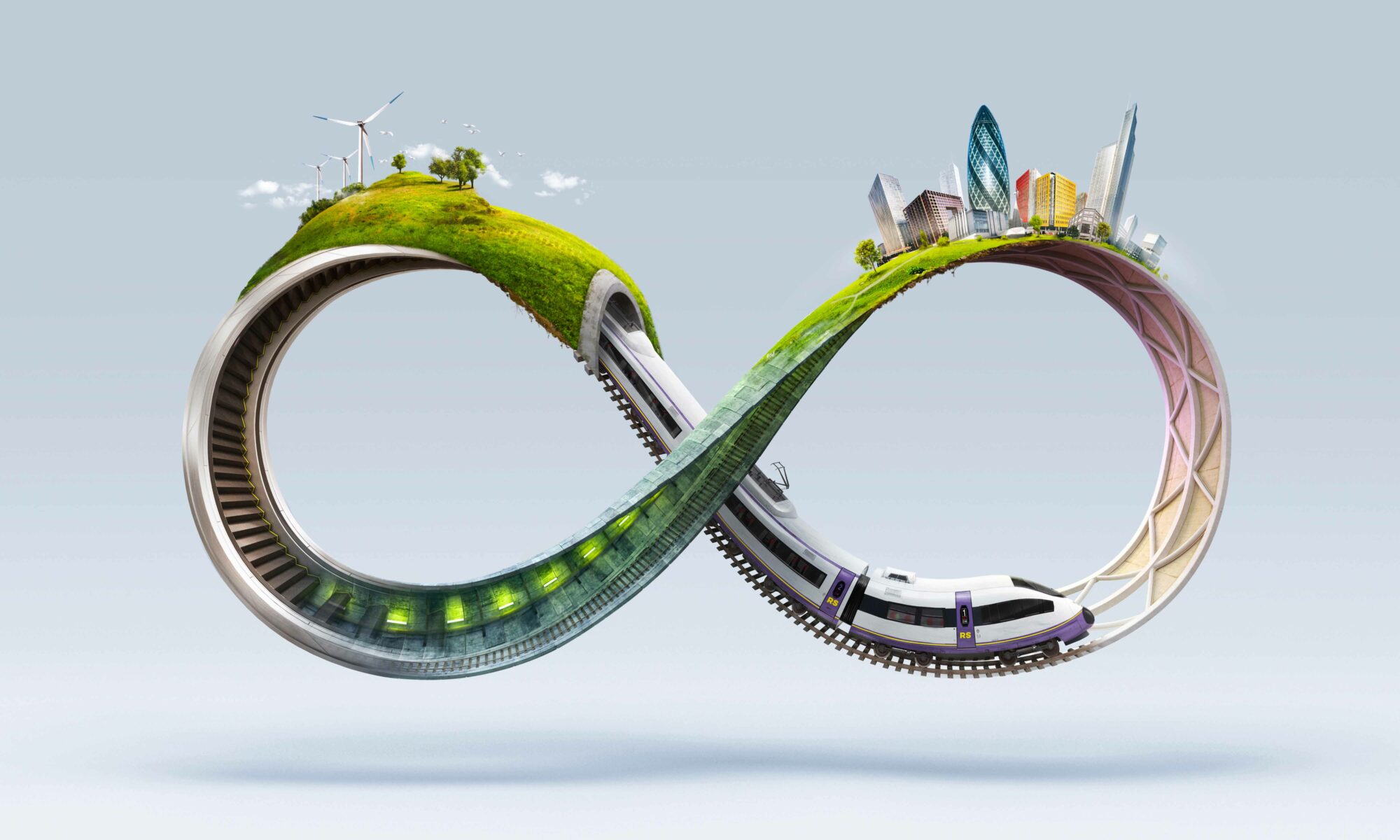Towards a circular economy
We live in a linear world. We extract raw materials from the earth and process them into products which are ultimately thrown away after use. It is becoming increasingly obvious that this take-make-waste model is unsustainable; we have been using the Earth’s resources at a rate the biosphere can’t replenish. Calls are loudening for a concerted shift towards a more circular economy.
According to the Ellen Macarthur foundation, a non-profit at the forefront of the circular transition, a circular economy is based on the principles of designing out waste and pollution, keeping products and materials in use, and regenerating natural systems1. To achieve this will entail mass industrial transformation, gradually decoupling economic activity from the consumption of finite resources. The circular model changes the way in which value is created and preserved, considering all the stages in the lifecycle of goods, while promoting more sustainable consumption practices.
The Linear Economy
Our current economic system does not operate in harmony with the Earth’s natural systems (which we have been pushing to their limits). According to crude estimates from Sir Partha Dasgupta2, we would need about 1.6 Earths to meet our current demands on a sustainable basis. To look at the problem from an annual perspective, each year, the Global Footprint Network calculates the “Earth Overshoot Day”: the calculated illustrative calendar date on which humanity’s resource consumption for the year exceeds Earth’s capacity to regenerate those resources that year. In 2020, that date was August 22nd.
As it stands, we extract resources, produce goods (sometimes even with planned obsoletion in order that consumers upgrade and renew periodically to ensure continued revenue streams), the goods are used and then disposed of. Along this cycle, the waste products generated are dumped back into the biosphere making it less able to offer the bedrock services we rely on.
The Linear Model

The result is an array of undesirable effects such as pollution, a loss of biodiversity, climate change and extreme weather. The clash of our economic and natural systems has led geologists to warn that we may have left the Holocene (the epoch we have lived in for over 10,000 years, which supported our civilization) and entered the Anthropocene, the era of humans dominating the earth3. Scientists reckon we have about a decade to reverse course – or else it could be too late.
Much of the problem is rooted in our primary measure of economic success – Gross Domestic Product (GDP).
Much of the problem is rooted in our primary measure of economic success – Gross Domestic Product (GDP). In February 2021, Dasgupta published a landmark review4 calling for change in our economic approach to nature. He points out that GDP does not account for the depreciation of assets, including the natural environment, therefore encouraging us to pursue unsustainable economic growth and development. The report marks the first step towards quantifying nature as our most valuable asset.
The Circular Economy

In a circular economy growth is redefined, focusing on positive society-wide benefits. Waste is minimised by considering the full lifecycle of materials in the design process and by encouraging greater re-use and recycling. Circularity seeks to avoid the over-exploitation of natural resources and is underpinned by the transition towards renewable energy sources. The European Commission identifies 9 “R” behaviours or principles5 that will help enable a circular economy, which we outline below with some basic examples.
| Principle | Description |
|---|---|
| Refuse | Make product redundant by abandoning its function or by offering the same function by a radically different (e.g. digital) product or service. Eg. BIL sending electronic statements, instead of physical letters which entail the use of paper, ink, plastic windows for envelopes, the postman’s fuel… |
| Re-think | Make product use more intensive (e.g. through product-as-a-service, reuse and sharing models or by putting multi-functional products on the market) Uber and other car sharing companies have reduced the need for people in cities to own cars, thereby reducing the number of manufactured vehicles that sit redundant for long periods of time. |
| Reduce | Increase efficiency in product manufacture or use by consuming fewer natural resources and materials Faith In Nature introduced “super concentrated” washing-up liquid which reduces water content in the solution, meaning that plastic packaging is downsized and consumers need to use less. |
| Re-Use | Re-use of a product which is still in good condition and fulfils its original function (and is not waste) for the same purpose for which it was conceived. The key to enable the reuse of goods and components is the standardisation of components, interfaces and materials, and the non-destructive collection of used goods. E.g. The standardised mobile phone recharger promoted by the European Commission. |
| Repair | Repair and maintenance of defective product so it can be used with its original function Patagonia offers to repair jackets for free on behalf of their clients in order to lengthen the product lifecycle. |
| Refurbish | Restore an old product and bring it up to date (to specified quality level) Fairphone allows its customers to update their smartphones by buying new versions of the individual components, rather than buying a whole new device – for example – you can buy and install a new camera on your old phone. |
| Remanufacture | Use parts of a discarded product in a new product with the same function (and as-new-condition) Canon uses cascading systems-thinking to capture resource value, and to prioritize product remanufacturing, component reuse and recycling. By collecting used equipment from the market, remanufacturing it and re-selling it with the same high-quality guarantee as original products. |
| Repurpose | Use a redundant product or its parts in a new product with different function The shoe brand Timberland collaborated with an tyre producers, Omni United, to transform used tyres into shoe soles. |
| Recycle | Recover materials from waste to be reprocessed into new products, materials or substances whether for the original or other purposes. Nespresso, which was highly criticised for the waste produced through their capsules put in place their own collection service in and a Phone app that helps you to locate the closest collection point. |
Source: European Commission, BIL
The Circular Economy and carbon emissions
Facing the climate emergency, governments around the world have pledged to achieve carbon neutrality by 2050. However, there are, as yet, few decisive pathways to get to net zero. A freshly published article published by the World Economic Forum6 began with the following two bullet points:
- Net zero cannot be achieved by decarbonizing the energy sector alone.
- Circularity is needed to tackle climate goals within the next decade.
Research by the Ellen MacArthur Foundation7 finds that switching to renewable energy can only cut greenhouse gas emissions by 55%. Whereas, a circular economy, underpinned by a transition towards renewable energy, could help tackle the “the overlooked 45% of emissions by targeting how goods are made and used”. And it is not just carbon-related goals that could be hindered if we do not move towards a more circular economic paradigm. Inger Andersen, Executive Director of the UN Environment Programme, has said: “Circularity and sustainable consumption and production are essential to deliver on every multilateral agreement, from the Sustainable Development Goals, to the Paris Agreement to the post-2020 global biodiversity framework that we must agree on soon. They are essential to a sustainable recovery from the pandemic.”
Regulators shape the playing field
If you watched the Social Dilemma on Netflix, you probably remember the chilling quote at the end from Justin Rosenstein a former engineering lead at Facebook.
We live in a world in which a tree and a whale is worth more financially dead than alive. For as long as corporations act in this way and are unregulated, these corporations are going to continue to destroy trees, to mine the earth…
It does seem that circularity could be the next area of regulatory focus, with Europe leading the way.
Any shift in economic behaviour will have to be driven by regulation, given that model that we have lived under for the best part of 150 years is so ingrained. It does seem that circularity could be the next area of regulatory focus, with Europe leading the way.
The EU already launched its circular economy action plan8 last March. It aims to make sustainable products the norm in the EU, empower consumers and public buyers and ensure less waste, focusing on the sectors that use most resources and where the potential for circularity is high such as: electronics and ICT; batteries and vehicles; packaging; plastics; textiles; construction and buildings; food; and water. This action plan constitutes one of the main building blocks of the European Green Deal, while the transition to a circular economy is one of six environmental objectives set out in the EU’s Taxonomy Regulation which entered into force on 12 July 2020.9
In February this year, the European Commission and the UN Environment Programme launched the Global Alliance on Circular Economy and Resource Efficiency (GACERE). Bringing together governments and relevant networks and organisations, GACERE aims to provide a global impetus for initiatives related to the circular economy transition, resource efficiency and sustainable consumption and production.
Looking East, the National People’s Congress, China’s top legislature, took place this March and 14th 5-year plan was unveiled. Environmental priorities are apparent throughout the plan and there are also elements of circularity. For example, the elimination of major demolition and construction projects (a significant source in all countries of primary material extraction, energy consumption, and carbon pollution in the processing of steel, cement, and other building materials…), in favour of the renewal of older neighbourhoods. For around a decade, China has led the world in promoting the recirculation of waste materials by setting targets and adopting policies, financial measures and legislation.
Implications for investors
With ESG-related products already mainstream, investments in vehicles linked to the circular economy could be the next frontier for investors looking to “make their money matter”. Dismantling the systems that have built up over time to support the linear economy will be no easy feat, and while governments can implement regulations, companies, investors, financial institutions and consumers will all have a role to play. If we are to implement the principles of the circular economy at a scale needed to tackle climate change, it will be a colossal challenge, one that is resource and capital intensive, as it incorporates the energy transition as well as a shake-up in almost every industrial process. But a circular economy isn’t just about fixing environmental wrongs, this will also present a whole range of opportunities for investors who pursue a double bottom line of profit and purpose. Already, certain names have started to offer funds that track companies linked to the Circular Economy and we think this is an investment theme set to gain a lot more traction in the near future – especially if regulators turn up the heat.
1 Ellen Macarthur Foundation – What is the circular economy? https://www.ellenmacarthurfoundation.org/circular-economy/what-is-the-circular-economy
2 Sir Partha Dasgupta was appointed by the British Chancellor of the Exchequer to lead an independent global review to assess the economic benefits of biodiversity and the economic costs of its loss.
3 World Economic Forum – How the circular economy can help the climate https://www.weforum.org/agenda/2021/03/how-the-circular-economy-can-help-the-climate/ and The Atlantic – Geology’s Timekeepers are Feuding https://www.theatlantic.com/science/archive/2018/07/anthropocene-holocene-geology-drama/565628/
4 The Dasgupta Review –https://assets.publishing.service.gov.uk/government/uploads/system/uploads/attachment_data/file/962785/The_Economics_of_Biodiversity_The_Dasgupta_Review_Full_Report.pdf
5 European Commission – Categorisation System for the Circular Economy – https://circulareconomy.europa.eu/platform/sites/default/files/categorisation_system_for_the_ce.pdf
6 World Economic Forum – How the circular economy can help the climate https://www.weforum.org/agenda/2021/03/how-the-circular-economy-can-help-the-climate/
7 Ellen MacArthur Foundation, Completing the Picture: How the Circular Economy Tackles Climate Change (2019) www.ellenmacarthurfoundation.org/publications
8 https://ec.europa.eu/environment/circular-economy/
9 https://ec.europa.eu/info/business-economy-euro/banking-and-finance/sustainable-finance/eu-taxonomy-sustainable-activities_en


 Mortgage
Mortgage Personal loan
Personal loan Savings
Savings